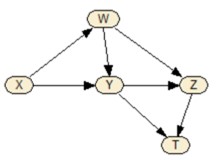Assigned Reading
- Session Overview
- Network Concept
- Student teachers
Assignment
Include in the first page a summary page. In the summary page
write statements comparing your work to answers given or videos. For
example, "I got the same answers as the Teach One video for question 1."
For these assignment you can use any statistical package, including R,
SAS, and SPSS, Python. R packages and BNLearn are also used often. OpenBUGS and
Gibbs Sampler, Stan, OpenMarkov, and Direct Graphical Model are also open
source software. Netica is free for networks less than 15 nodes.
Question 1: This problem is based on example 1.2.1
in the Causal Inferences in Statistics book. An AI system provided advice
on antidepressants based on patient's medical history. The advice
was provided to 700 clinicians at point of care, 350 chose to follow the advice. Table below shows
the number of patients of the clinicians recovering from depression.
- Is the AI system effective for men?
- Is the AI system effective for women?
- Is the AI system effective across the population, if we do not know the gender of the person?
|
Number of Patients Recovering |
|
|
Advice
Followed |
Advice Not
Followed |
| Men |
81 (n=87) |
234 (n=270) |
| Women |
192 (n=263) |
55 (n=80) |
| Total |
273 (n=350) |
289 (350) |
Resources for Addressing Question 1:
- Download and copy paste the content of this document into a Large
Language Model.
Intelligent Tutor►
Question 2: Calculate the following probabilities
using the data in the following Table
- Probability of being 18 to 29 years old
- Probability of being 30 to 40 years old given that you are at
least 29 years old
- Expected value of age
|
Age Group |
# of
voters |
| 18-29 |
20,539 |
| 30-44 |
30,756 |
| 45-64 |
52,013 |
| 65+ |
29,641 |
Question 3: Using the following graph, answer the
following questions:
- Name variables that precede Z
- Name variables that are not correlated with Z
- Name all of the parents of Z
- Name all of the ancestors of Z
- Name all of the children of W
- Name all of the descendants of W
- Identify all simple paths between X and T, where no node appears
more than once
- Draw all directed paths between X and T
- What is the definition of a directed a-cyclical graph (DAG), and is this
graph a DAG?
- What is the common cause of Y and Z?

Question 4: Draw networks based on the following independence assumptions.
When directed networks are possible, give formulas for predicting the last variable in the networks from marginal and pair-wise conditional probabilities. Keep in mind that
absence of
independence assumption implies dependence.
Resources for Question 4:
| Nodes in Network |
Assumption |
| X, Y,
Z |
I(X,Y) |
| X, Y,
Z |
I(X,Y), Not I(X,Y|Z) |
| X, Y,
Z |
I(X,Y), I(X,Y|Z), Y
measured last |
| X, Y,
Z, W |
I(X,Y), I(X,Y|Z),
I({X,Y},W|Z), W measured last |
| X, Y,
Z, W |
II(X,Y), I(Z,W), and
X measured before Z and Y measured before W |
Optional Question 5: This problem comes from study question 1.3.2 in Causal
Inference in Statistics. Using the proportion of male and females
achieving a given level of education, calculate the following
probabilities:
- Estimate p(High School)
- Estimate p(High School OR Female)
- Estimate p(High School | Female)
- Estimate p(Female| High School)
|
Education |
Male |
Female |
| Never
Finished High School |
112 |
136 |
| High
School |
231 |
189 |
|
College |
595 |
763 |
|
Graduate School |
242 |
172 |
More
For additional information (not part of the required reading), please see the following links:
- Introduction to causal inference
Read 1►
Read 2►
Video►
Slides►
- Meta analysis through Bayesian networks
Read►
- Introduction to Bayesian networks
Read►
- Learning Bayesian Networks
Read►
- Selection of Judea Pearl's articles
PubMed►
- Applications of Bayesian networks in healthcare PubMed►
- Bayesian networks in neuroscience Read►
- Cost analysis using Bayesian networks Read►
- Bayesian network classifiers
Read►
This page is part of the course on Comparative Effectiveness by Farrokh Alemi, Ph.D.
Course Home►
Email►
|
